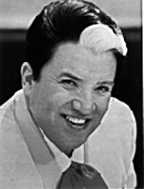Miguel Aceves Mejía
| Miguel Aceves Mejía | |
|---|---|
 | |
| Background information | |
| Birth name | Miguel Aceves Mejía |
| Born |
15 November 1915 Chihuahua, Chihuahua, Mexico |
| Died |
6 November 2006 (aged 90) México City, México |
| Occupations | Singer, actor |
| Years active | 1945-2006 |
Miguel Aceves Mejía (November 15, 1915 – November 6, 2006) was a Mexican actor, composer, and singer.
Miguel Aceves Mejía, or "the King of the falsetto" as he was popularly known, was born in Ciudad Juárez in the state of Chihuahua. He became a popular Mexican film star during its golden age and was widely regarded for his interpretations of various Mexican musical folkloric genres, particularly the ranchera.
Originally part of a traveling theater company, Aceves began recording for the first time in 1938 with the trio Los Porteños. At the beginning of his career he interpreted mainly boleros, tangos, and Afro-Cuban rhythms. During his career he recorded more than 1000 songs on 90 discs and starred in over 60 films.
Among his greatest hits are La Barca de Guaymas, El Pastor, La del Rebozo Blanco, Se Me Hizo Fácil, Yo Tenía un Chorro de Voz, Vaya con Dios, La Malagueña Salerosa, El Jinete, El Crucifijo de Piedra and Cuatro Caminos. He was noted for composing such songs as El Pescado Nadador and O, Gran Dios, even though his forté was primarily as a singer in his own right.
Following the rise to popularity of Jalisco-born ranchera singer, David Záizar. Mejía's status as "the King of the falsetto" was given to Záizar by the public.
In 1945, Aceves began dedicating himself solely to singing and, following the deaths of Pedro Infante and Jorge Negrete, ventured into the world of cinema.
In 1959 he appeared in Amor se dice cantando.
Aceves died just a few days short of his 91st birthday on November 6, 2006 in Mexico City. As is tradition in Mexico, his body lay under the rotunda of the Palacio de las Bellas Artes (Palace of Fine Arts) in Mexico City. This honour is reserved for only the greatest Mexican figures of arts and letters.
External links
- Miguel Aceves Mejía at the Internet Movie Database
- El Mundo
- Miguel Aceves Mejía, perfil
- Biografía de Miguel Aceves Mejía
|